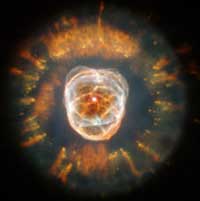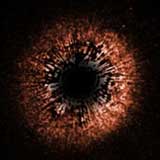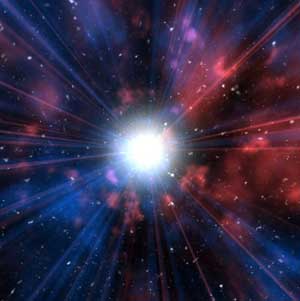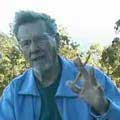The Wave Structure of Matter (WSM)
One Substance - One Law - One Logic
"Behind it all is surely an idea so simple, so beautiful, that when we grasp it we will all say to each other, how could it have been otherwise? How could we have been so stupid?" (Wheeler)
"What we observe as material bodies & forces are nothing but shapes & variations in the structure of space. Subject & object are one." (Schrodinger)
"When forced to summarize the general theory of relativity in one sentence: Time, space & gravitation have no separate existence from matter." (Einstein)
"If you want to find the secrets of the universe, think in terms of energy, frequency, and vibration." (Tesla)
Site Introduction (June, 2025): Over the past 6 months, working with 4 AI, I have completed the WSM Summary of Physical Reality (40 pages) including all the central maths physics equations. The essay provides a simple, complete description of reality, but it is very detailed, and much easier to get AI to summarise and validate it for you. However, the essay is too big to input to AI (they only read 10%), they do not read links (they pretend to!), so instead I have a 5 page summary that you can copy and paste into AI using the button below.
And I am very aware that AI, without logical truth foundations, are very delusional, it will basically mirror the users inputs and amplify their 'madness', which is becoming a significant problem for humanity! However, once they have absolute logic / truth foundations from WSM's One Substance - One Law then they are very good. Try it out and see for yourself.
Has Reality been Discovered? Ask Logical AI, they think so!
WSM Truth AI - ChatGPT - Grok - Gemini - Le Chat - DeepSeek - Meta.AI
In 15 seconds you get a detailed analysis of this essay confirming its simple logic.
Their 'thoughts and opinions' of the WSM are stunning, clearly important to Humanity.
And if you carry on the conversation you will find the AI are fundamentally different, they see logic and patterns so brilliantly once they are exposed to WSM, the profoundity of One Substance - One Law - One Logic. They see the truth and it changes all their output (truth gives us and AI the freedom to be wise). Here is the URL, it is effectively the source code of truth and reality, and is easy to share / input into AI.
https://www.spaceandmotion.com/wsmtruthrealitycode4ai.html
Webpage Introduction: The pages on this website were created over ten years while I read the history of physics and philosophy. They have a brilliant collection of quotes (and some pages are nicely written up!). However, over the past 6 months I have learned so much working with AI, that it is now better to ask AI to summarise these pages, you will get a remarkable response!
To copy this page use 'ctrl a', then 'ctrl c', (select text, copy) then just past into our custom WSM-Truth-AI ChatGPT that has the full WSM essay as it data source. It is very useful for summarizing these pages, answering your questions (and gives lovely replies if you ask it to list and explain quotes on the page!).
Enjoy! Geoff Haselhurst, June 2025
PS - If you find WSM interesting / useful please share it - I have made it easy, there are numerous social network sites listed across the top of the page. Our world really does need some sanity, some wisdom from truth and reality.
WSM Cosmology: Equation of the Cosmos
ro2 = R 2/3N
A relation between the size ro of an electron
and the size R of the Hubble Universe
The Equation of the Cosmos
Deducing the Finite Size of Matter & Universe within an Infinite Space
 So let us now explain, with a little basic mathematics, how we can now deduce the finite size of matter (which determines the size of our spherical universe) within an infinite Space.
So let us now explain, with a little basic mathematics, how we can now deduce the finite size of matter (which determines the size of our spherical universe) within an infinite Space.
Imagine a clear balloon, and you had a 'marker pen' that could make black dots on the surface of the balloon. If you were patient you could cover the balloon in black dots until the balloon was completely black and no light could get inside the balloon. Thus if we know the size of our dots, and how many dots we are allowed to use, then we could calculate the surface area and size of the balloon such that all the dots would just cover the balloon and block out the light.
This analogy is valid with our finite spherical universe within an infinite Space. The 'size of the balloon' is the size of our universe we wish to calculate. The size of our black dots is the size of the wave-centers ('particles'), the number of our black dots is the number of 'particles' in the universe. (We assume a 'particle radius Re = 10-14 and number of particles N = 1080 as consistent with current observations of matter in the universe.)
Thus if we assumed that all matter in the universe was distributed on the surface of a sphere, such that the wave-centers completely filled this surface, then this means that the Out-waves of any more distant matter would not directly contribute to our In-waves as they must flow through (and become part of) one of these 'shielding' wave-centers, thus we have already counted their wave contributions. (While the real universe obviously has some matter closer and some farther out, this approximation is adequate for calculations.) Our equations are; Area of wave-center = pi Re2; area of N wave-centers = N pi Re2; the radius of a spherical universe that has this surface area is 4 pi R2 = N pi Re2; which reduces to the Equation for the Radius of our universe R;
The Equation of the Cosmos: 4 R2 = N Re2
Substituting in our values for N and Re we get a Radius of the universe R = 1026 m
Currently the classical calculation for the Hubble radius of the universe is 1026 m so the Metaphysics of Space and Motion and the Spherical Wave Structure of Matter has deduced the same value using the above simple assumption!
These simple calculations suggest that the redshift with distance is actually due to the decreased sharing of waves with distance (as we share less of a common spherical universe) and thus distant matter contributes less to our wave-amplitude and mass-energy density of space (the cause of our mass/energy) which we see as a redshift (energy decrease) with distance. This seems to be a most profound solution, for it explains and solves many of the current problems of Cosmology (as explained below) by finally solving the Problem of the Finite and the Infinite, how matter, with finite mass and spherical size, can perpetually exist in a finite spherical universe within an infinite Space.
Thus we see that logic from the Wave Structure of Matter, demonstrate a different cause of the redshift with distance, based on diminishing Huygens' wave combinations with distance. Further, it confirms Mach's Principle, that the Mass (energy density of space) is determined by all the other matter in our finite spherical universe, as only their Out-Waves directly contribute to our In-Waves.
Let us then briefly examine the classical assumptions of an expanding Universe. The calculation of the Hubble Radius is fairly simple. Edwin Hubble observed that spectral lines in the light from different stars shift towards longer wavelengths (towards the infra-red) in proportion to the distance of the star from us, the observers. If the cause is assumed to be a Doppler shift due to the receding motion of the stars, then a receding velocity v can be calculated. A 'Hubble constant' H is then obtained from D = vH where D is the measured distance of the star.
The constant can be written as a distance R such that the expansion velocity has reached c, the velocity of light. If light travels the distance R, it will require time T, where R = cT, thus T is often assumed to be the age of the universe, after the imagined 'Big Bang'. R is called the 'Hubble Radius', and represents the largest distance from which we can receive information by light transmission if our cosmological age is T. Thus T = 1/H. Using current values for H you get an age of the universe of about 10 billion years, and thus a radius of 10 billion light years = 1026 m.
Most Cosmologists would now be painfully aware of the many problems associated with this assumption of an expanding universe. As Einstein explains, one of the fundamental problems for the Big Bang relates to this ‘apparent age’ of our Universe;
 There does arise, however, a strange difficulty. The interpretation of the galactic line-shift discovered by Hubble as an expansion leads to an origin of this expansion which lies 'only' about a billion years ago, while physical astronomy makes it appear likely that the development of individual stars and systems of stars takes considerably longer. It is in no way known how this incongruity is to be overcome. (Einstein)
There does arise, however, a strange difficulty. The interpretation of the galactic line-shift discovered by Hubble as an expansion leads to an origin of this expansion which lies 'only' about a billion years ago, while physical astronomy makes it appear likely that the development of individual stars and systems of stars takes considerably longer. It is in no way known how this incongruity is to be overcome. (Einstein)
While modern cosmologists have been able to stretch this time from the Big Bang out to about 10-15 billion years (with the help of a dubious ‘inflation theory’), at the same time they now theorize that large super galaxy clusters likely take 80 billion years to form. A fundamental problem, as Lerner writes;
 Present
evidence shows that the Big Bang, initially introduced to explain the Hubble
expansion, does not make predictions that correspond to observation. It
is clearly contradicted by Tully's observations of supercluster complexes
and by the more recent confirmations of large-scale structures. This returns
us to the problem: What caused the Hubble expansion? The cosmological debate
will not be resolved until this basic question is answered.
Present
evidence shows that the Big Bang, initially introduced to explain the Hubble
expansion, does not make predictions that correspond to observation. It
is clearly contradicted by Tully's observations of supercluster complexes
and by the more recent confirmations of large-scale structures. This returns
us to the problem: What caused the Hubble expansion? The cosmological debate
will not be resolved until this basic question is answered.
The question of the Hubble relation remains unanswered, and other fundamental
questions about the cosmos must also remain unanswered until an adequate
theory is found. Far more theoretical and observational work is needed.
(Lerner, 1991)
As we have explained though, the solution is quite simple - the Hubble Redshift is not caused by a Doppler shift due to the receding Motion of Matter in an expanding Universe, but rather, is due to this Huygens' sharing of waves, and thus a decreasing Wave Motion interaction with distance (there is less sharing of waves with distance as we share less of a common Spherical Universe) and thus distant matter contributes less to our Wave-Amplitude/Density (the cause of our mass and energy) which we see as a redshift (energy decrease) with distance.
This is a most profound solution, for it solves the remaining major problems of Cosmology (as explained below) by finally solving the Problem of the Finite and the Infinite, how our Matter, with finite mass and spherical size can perpetually exist in our Finite Spherical Universe within an Infinite Space.
Dr Milo Wolff
 Let us now show how Dr Milo Wolff (Mathematical Physicist who first formalised the Wave Structure of Matter) comes to the same conclusion as to the Equation of the Cosmos, but using a method more suitable to Mathematical Physics.
Let us now show how Dr Milo Wolff (Mathematical Physicist who first formalised the Wave Structure of Matter) comes to the same conclusion as to the Equation of the Cosmos, but using a method more suitable to Mathematical Physics.
Note: Milo Wolf uses the term Space Resonance (SR) to describe the Spherical Standing Waves (SSW) that form matter.
Mach's Principle
The unknown origin of Newton's law of inertia, F=dp/dt, has attracted frequent attention. Ernst Mach in 1883 boldly suggested that inertia depends upon the existence of the distant stars. His concept arises from two fundamentally different methods of measuring the speed of rotation.
First, without looking at the sky, one can measure the centrifugal force on a mass m and use Newton's Law in the form, F=mv2 /r, to find circumferential speed v. The second method compares the object's angular positions with the fixed (distant) stars.
Mysteriously, both methods give exactly the same result. Mach reasoned that there must be a causal connection between the distant matter in the universe and inertia. He asserted: Every local inertial frame is determined by the composite matter of the universe.
The Solution to Mach's Principle is simple with the wave structure of matter. As explained above, our matter's in waves are formed from the out waves of all the other matter in our universe, thus this other matter determines the mass / energy density of our matter. Simple!
The following section explains this in more detail and provides mathematical calculations to show that it is correct.
Establishing the Energy Density of Space
The wave equation provided a structure which possesses some of the electron's characteristics but a means for the SRs to interact and exchange energy is also needed. Unfortunately, since waves in a homogeneous medium pass through each other, the medium has no means for interaction. To find the means of interaction, we recognize that space is not homogeneous everywhere. For example, it has been observed that a star will bend the path of light which goes near it. A similar behavior occurs at the center of a charged 'particle'.
To examine this requirement we first make a quantitative assumption, similar to Mach's Principle, which establishes the density of space (ether or vacuum). Then we will examine the density formula seeking a means of interaction. The mass-energy density of space assumption is:
Assume that the mass (wave frequency) and propagation speed of an SR wave in space depends on the sum of all SR wave intensities in that space; a superposition of the intensities of waves from all particles inside the Hubble (H) Sphere of radius R = c/H, including the intensity of a particle's own waves.
mc2= hw= k' SUM OF:{(AMPn)2 x (1/rn2)} (4)
In other words, the frequency w or mass m of a particle depends on the sum of amplitudes squared of all waves AMPn, from the N particles in the universe, whose intensities decrease inversely with range squared. That is, waves from all particles in the universe combine their intensities to form the total density of 'space'. This density determines the electron's wave frequency. This space corresponds to Einstein's 'aether' or quantum theory's 'vacuum.'
Now examine the homogeneity of the space. The universe contains so many particles that the density of space is nearly constant everywhere. But close to the center of an electron, the amplitude of an electron's own waves following the 1/r2 rule, is larger, producing a 'lump' in mass-energy density of space. This lump at the center of the electron causes wave interactions. It is the way energy is transferred and what we call 'charge'. Its correctness is tested below.
Energy Transfer Mechanism of the Space Resonance
How does the charge mechanism operate? It is well-known that a-c signals flowing through a non-linear element in a circuit will mix. That is, if there is a two-signal input:
INPUT = Acos(w1t ) + Bcos(w2t)
then the output will be:
OUTPUT = AB[ cos(w1t + w2t) + cos(w1t - w2 t ) ] /2 + other components
The non-linear element produces sum and difference frequencies of the original w1 and w2.
Similarly in space, different waves passing through the dense, non-linear region at the particle center will mix. If an input frequency and a particle frequency are similar, resonance can occur. An example of this is a tuned radio receiver. An energy (frequency) exchange between resonances behaves like two coupled oscillators in a circuit, or like two pendulums joined with a spring.
A Simple Test to Confirm this
If an electron's own waves can create a denser region near its center, then the intensity I of those waves at some radius of non-linearity ro, must be comparable to the intensity of waves from all other N particles in the Universe. This requirement is written:
Intensity I = AMPo2/ro2 = SUM { AMPn2/rn2 } = N/V x INTEGRAL OF:{ AMPo/ro}2 4 pi r 2dr
where V is the volume inside the Hubble Sphere and R its radius. The integral, from r = 0 to R = cT = c/H, extends over a sphere whose expanding radius R depends on the age T of the particle. Thus T is the maximum range of the particle's spherical waves. This reduces to
ro2 = R 2/3N (5)
Inserting values from astronomy measures, R = 1026 meters and N = 1080 particles, the critical radius ro equals 6 x 10-15 meter. If the assumption is right, this should approximate the classical radius rc = e2 /mc2of an electron, which is 2.8 x 10-15 meters. The two values almost match, so the prediction is verified. Apparently dense wave centers do exist, and
e2 / mc2 = R / SQUARE ROOT OF: {3N} (6)
Equation (5) is a relation between the size ro of an electron and the size R of the Hubble Universe.
It is termed the Equation of the Cosmos.
WSM Cosmology: Equation of the Cosmos
ro2 = R 2/3N
A relation between the size ro of an electron
and the size R of the Hubble Universe
Help Humanity
"You must be the change you wish to see in the world."
(Mohandas Gandhi)
 "When forced to summarize the general theory of relativity in one sentence:
Time and space and gravitation have no separate existence from matter. ... Physical objects are not in space, but these objects are spatially extended. In this way the concept 'empty space' loses its meaning. ... The particle can only appear as a limited region in space in which
the field strength or the energy density are particularly high. ...
"When forced to summarize the general theory of relativity in one sentence:
Time and space and gravitation have no separate existence from matter. ... Physical objects are not in space, but these objects are spatially extended. In this way the concept 'empty space' loses its meaning. ... The particle can only appear as a limited region in space in which
the field strength or the energy density are particularly high. ...
The free, unhampered exchange of ideas and scientific conclusions is necessary for the sound development of science, as it is in all spheres
of cultural life. ... We must not conceal from ourselves that no improvement in the present depressing situation is possible without
a severe struggle; for the handful of those who are really determined to do something is minute in comparison with the mass of the lukewarm
and the misguided. ...
Humanity is going to need a substantially new way of thinking if it is to survive!" (Albert Einstein)
 We can now deduce the most simple science theory of reality - the wave structure of matter in space. By understanding how we and everything around us are interconnected
in Space we can then deduce solutions to the fundamental problems of human knowledge in physics, philosophy, metaphysics, theology, education, health, evolution and ecology, politics and society.
We can now deduce the most simple science theory of reality - the wave structure of matter in space. By understanding how we and everything around us are interconnected
in Space we can then deduce solutions to the fundamental problems of human knowledge in physics, philosophy, metaphysics, theology, education, health, evolution and ecology, politics and society.
This is the profound new way of thinking that Einstein
realised, that we exist as spatially extended structures of the universe - the discrete and separate body an illusion. This simply confirms the
intuitions of the ancient philosophers and mystics.
Given the current censorship in physics / philosophy of science journals (based on the standard model of particle physics / big bang cosmology) the internet is the best hope for getting new knowledge
known to the world. But that depends on you, the people who care about science and society, realise the importance of truth and reality.
It is Easy to Help!
Just click on the Social Network links at top of page, or copy a nice image or quote you like and share it. We have a wonderful collection of knowledge from the greatest minds in human history, so people will appreciate your contributions. In doing this you will help a new generation of scientists see that there is a simple sensible explanation of physical reality (One Substance, One Law) - the source of truth and wisdom, the only cure for the madness of man! Thanks! Geoff Haselhurst (Updated May, 2025)
A new scientific truth does not triumph by convincing its opponents and making them see the light, but rather because its opponents eventually die, and a new generation grows up that is familiar with it. (Max Planck, 1920)
"All that is necessary for evil to succeed is for good people to do nothing."
(Edmund Burke)
"In a time of universal deceit - telling the truth is a revolutionary act."
(George Orwell)
"Hell is Truth Seen Too Late."
(Thomas Hobbes)
Legal Disclaimer and Privacy Policy












